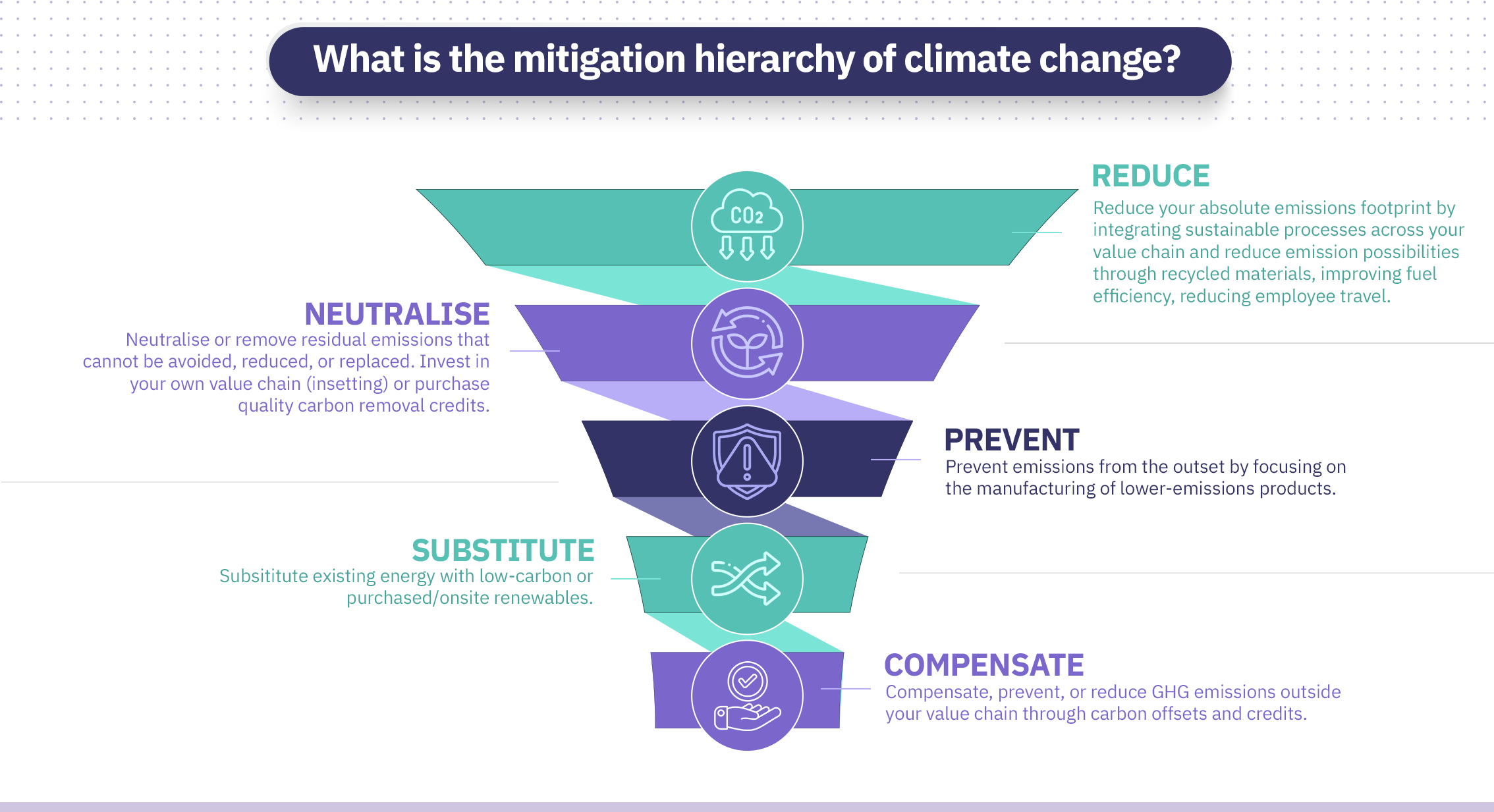Summary
- The mitigation hierarchy is a structured framework that helps businesses prioritize emission reductions through strategies such as prevention, reduction, substitution, neutralization, and compensation, guiding them toward Net Zero goals.
- International collaborations, including the Kyoto Protocol and the Paris Agreement, play a significant role in climate change mitigation, emphasizing both global commitments and localized strategies to enhance environmental accountability.
- Companies must consider urgency, effectiveness, and cost when prioritizing decarbonization efforts, with a focus on aligning sustainability goals with business strategies to effectively contribute to climate action.
As governments all around the world prioritize climate change mitigation and adaptation, the mitigation hierarchy of climate change has emerged as a structured framework for companies planning climate action. Opportunity and capital costs are critical considerations in climate change mitigation as well, whilst businesses grapple with pressing consumer and investor demands for green credentials. Hence, this article delves directly into the mitigation hierarchy and its importance in the pursuit of climate change mitigation.
The Mitigation Hierarchy of Climate Change: An Overview
A mitigation hierarchy represents a top-level strategic approach that companies use to prioritize emission reductions. Just like a funnel, climate action at the level of business operation is widest at the top because of the availability of strategy, before tightening in scope and the number of solutions available. As companies go lower in the funnel, they too go deeper into building emissions reduction. The funnel is structured through prevention, reduction, substitution, neutralization, and compensation. It thus guides a business’ Net Zero strategy towards selecting the most appropriate, efficient emissions reduction.
Beyond what the climate change mitigation hierarchy is composed of, what is more critical is what it represents. Indeed, the hierarchy codifies environmental consciousness, especially as emissions reductions are what guide its individual actions. To create operational resilience and comply with any potential regulations, businesses must recognise that environmental management is an integrated philosophy. Rethinking the materiality of businesses on the environment around them is what spreads the ethos of climate responsibility, and helps businesses achieve their climate goals.

What are Existing International Mitigation Efforts that Tackle Climate Change?
Beyond efforts at the individual and company-level, international collaboration is critical in marshaling collective resources towards mitigating climate change. Beyond diplomatic dialogue and political boundaries, commitments have also been enshrined in international agreements. Global climate mitigation frameworks include:
- The Kyoto Protocol and its successors: The Kyoto Protocol, a landmark international agreement which came into effect in 2005, set the stage for collective action towards climate change mitigation and adaptation. Its successive frameworks have built upon its foundation with more ambitious targets, and efforts.
- The Paris Agreement and Nationally Determined Contributions (NDCs): The Paris Agreement is perhaps the most notable climate target that is adhered to by governments and businesses globally. NDCs, individual commitments made by participating nations, showcase a diversified and cohesive approach to mitigation. Their increasing scope over five years emphasizes stronger efforts towards climate action and they symbolize the intersection of global goals and localized strategies.
The power of climate change mitigation is not solely vested in international agreements but also lies within the daily choices of individuals and the initiatives of companies of all sizes across industries. These micro-level efforts work towards building a culture of environmental accountability, driving change from the ground up.
Prioritizing Strategies in Climate Change Mitigation
When considering how best to prioritize decarbonisation, consider the following criteria to take, based on urgency, effectiveness, and cost.
Urgency & duration
When considering the urgency and duration of decarbonisation, account for specific schedules set by your organization. Based on Terrascope’s predictions, there is a crucial three-year period where companies should develop reporting capabilities, especially when considering growing regulatory and stakeholder pressure, and the comparatively lower costs of measurement and material disclosure. Still, companies doing so may want to consider the following when considering the urgency of decarbonisation:
- What existing timetables are in play for your organization to reduce emissions?
A company’s business strategy may be more tied to sustainability than you might think, especially when you consider that the Earth’s resources are finite, and ever-threatened by climate change. Capital may also have been provided to it, with the guarantee of having met climate goals. If your business commits to a target to achieve net-zero and fails, it may be liable to direct financial or litigation risk. - Are your commitments tied to reporting deadlines?
Organizations such as CDP, or the SBT, have specific reporting deadlines for you to submit your disclosures. If disclosures are not completed by the deadlines given, your company may not be able to be reliably certified by your auditing organization. Beyond non-governmental efforts, reporting requirements may also be tied to national regulations. Missing these disclosure cutoffs may result in litigation risk and financial penalty.
Effectiveness
With global climate and weather patterns changing because of global warming, businesses looking to make concrete action can abide by the following criteria. For one,
- How are you visualizing your progress as an organization?
Too often, companies lack foresight into mitigation actions they can take. Whether this is because of internal pressure or knee-jerk business strategy, any decision related to climate must be taken holistically and with the right data. Being unable to assess your progress is worse than having no progress at all, and being able to document and see your efforts underpins any strategy. - What progress are you making on emissions reduction?
Mitigation efforts curb greenhouse gas emissions, and reduce the magnitude of the greenhouse effect. This has a profound effect on affecting global climate and weather patterns based on global warming. The possible threat of environmental catastrophe is greatly diminished for current and future generations. Making progress is being more cognizant of your own company’s environmental footprint.
Cost
- Does your organization still subscribe to the perception of a ‘green premium’?
While the initial investment is high, the concept of a ‘green premium’ is becoming increasingly outdated, with the comparatively higher fixed costs of ignoring one’s own materiality vis-a-vis the environment higher than the costs of taking ownership. Indeed, adopting sustainable practices can be more affordable in the long run, especially as it builds a culture of accountability and leanness that encourages the strategic, efficient use of limited resources. Profitability and environmental consciousness can work with one another in the broader context of climate change. - What resources can you dedicate to emissions reduction?
Mitigation of an organization’s own materiality does not necessarily compromise other business goals. Beyond the technical targets, does your organization have the ability to dedicate some resources and time towards protecting the Earth for future generations? Adopting the mitigation hierarchy should be the default in a climate situation where environmental sustainability is inseparable from social and economic well-being.
Conclusion
For businesses, the carbon mitigation hierarchy serves as a structured approach to navigate the complex landscape of greenhouse gas reduction. Like a forward-thinking nutrition plan that adapts to evolving needs, the mitigation hierarchy empowers businesses to find the optimal blend of actions to achieve a sustainable future. The mitigation hierarchy is practical, reasoned guidance for structuring existing climate plans. It also charges companies with an added responsibility to take environmentally conscious business practices. Such mindfulness can illuminate future approaches and be instrumental in shaping a resilient and environmentally conscious tomorrow.
Still uncertain on how best to prioritize your climate mitigation strategies? Contact us below.



